Industrial Innovation: Analysis of Telecommunication Industry
VerifiedAdded on 2019/11/26
|13
|2900
|179
Report
AI Summary
This report delves into the realm of industrial innovation, focusing specifically on the telecommunication sector. It begins by outlining the structure of an economic system, highlighting the roles of the primary, secondary (industrial), and tertiary (service) sectors. The report then concentrates on the telecommunication industry, emphasizing its evolution and the impact of broadband services. It examines innovative focuses, including television, telephony, and internet access, and differentiates between in-network and over-the-top service innovations. Furthermore, the report analyzes research and development, business model innovations, and barriers to innovation within the industry. It also explores the role of government involvement in fostering innovation, such as providing infrastructure and financial support. The report concludes by underscoring the importance of innovation for the survival and prosperity of any economic sector, particularly the industrial sector. The study also highlights the need for government intervention to help drive innovation.

Running head: INDUSTRIAL INNOVATION
INDUSTRIAL INNOVATION
Name of the Student
Name of the University
Author note
INDUSTRIAL INNOVATION
Name of the Student
Name of the University
Author note
Paraphrase This Document
Need a fresh take? Get an instant paraphrase of this document with our AI Paraphraser
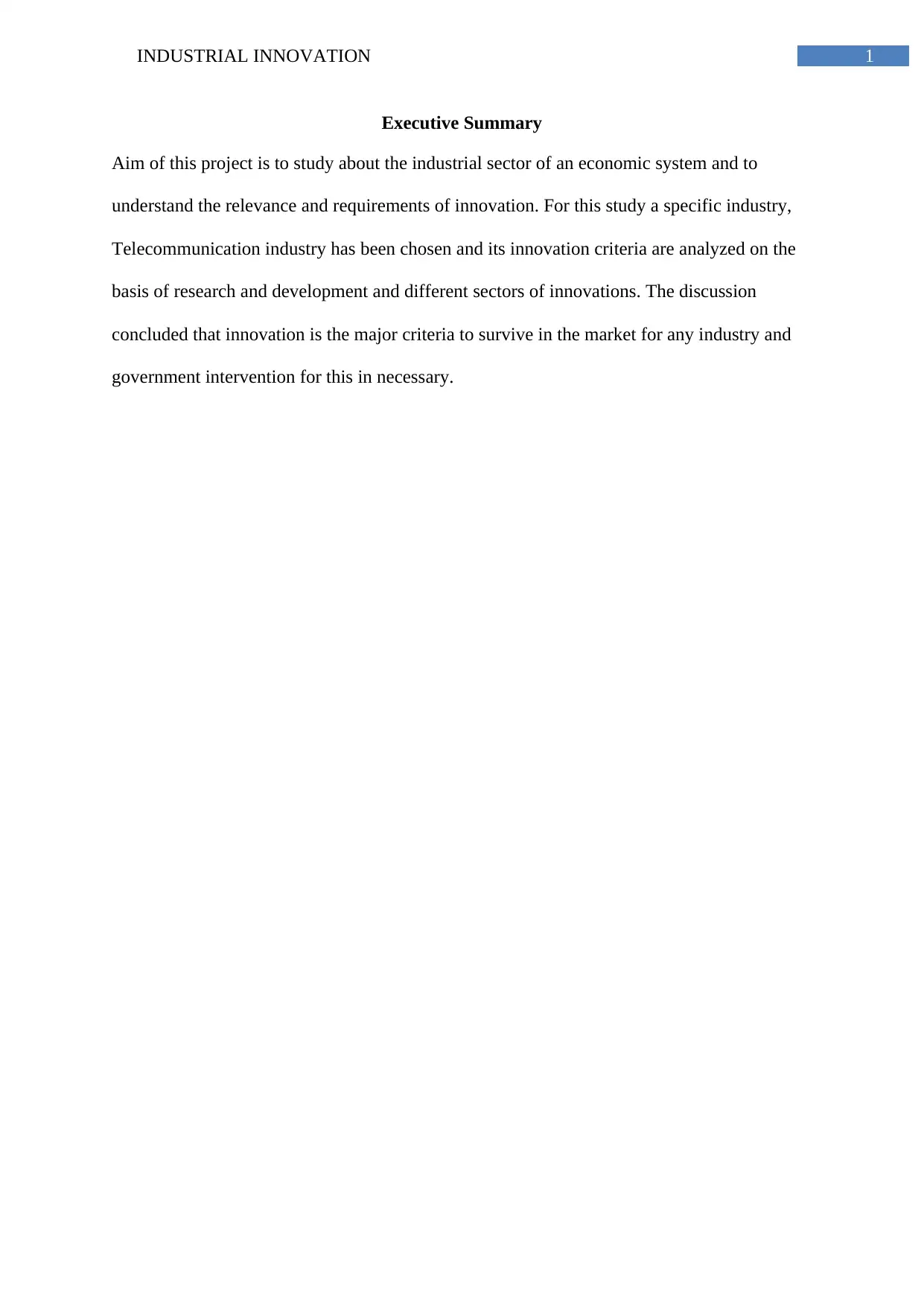
1INDUSTRIAL INNOVATION
Executive Summary
Aim of this project is to study about the industrial sector of an economic system and to
understand the relevance and requirements of innovation. For this study a specific industry,
Telecommunication industry has been chosen and its innovation criteria are analyzed on the
basis of research and development and different sectors of innovations. The discussion
concluded that innovation is the major criteria to survive in the market for any industry and
government intervention for this in necessary.
Executive Summary
Aim of this project is to study about the industrial sector of an economic system and to
understand the relevance and requirements of innovation. For this study a specific industry,
Telecommunication industry has been chosen and its innovation criteria are analyzed on the
basis of research and development and different sectors of innovations. The discussion
concluded that innovation is the major criteria to survive in the market for any industry and
government intervention for this in necessary.
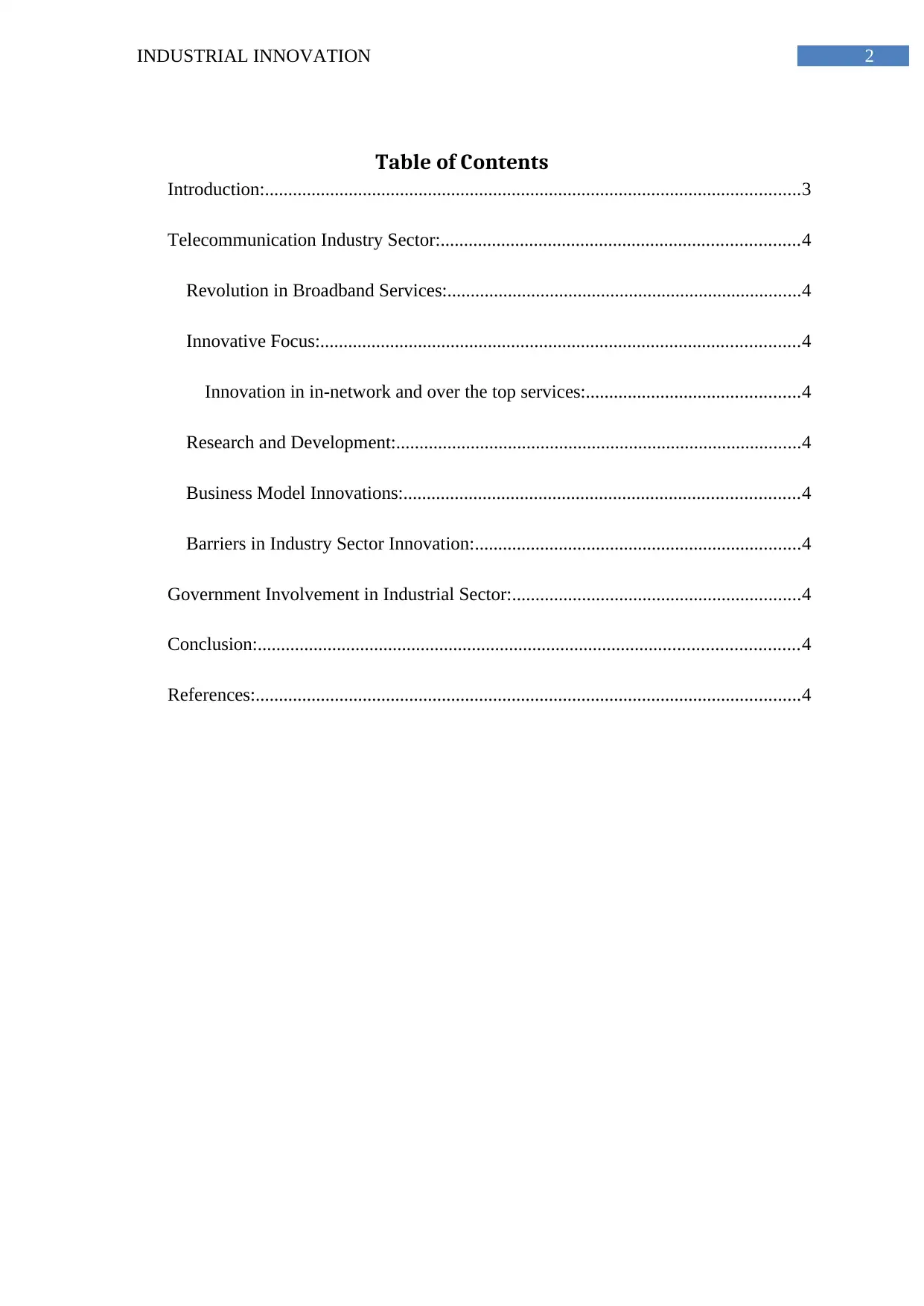
2INDUSTRIAL INNOVATION
Table of Contents
Introduction:...................................................................................................................3
Telecommunication Industry Sector:.............................................................................4
Revolution in Broadband Services:............................................................................4
Innovative Focus:.......................................................................................................4
Innovation in in-network and over the top services:..............................................4
Research and Development:.......................................................................................4
Business Model Innovations:.....................................................................................4
Barriers in Industry Sector Innovation:......................................................................4
Government Involvement in Industrial Sector:..............................................................4
Conclusion:....................................................................................................................4
References:.....................................................................................................................4
Table of Contents
Introduction:...................................................................................................................3
Telecommunication Industry Sector:.............................................................................4
Revolution in Broadband Services:............................................................................4
Innovative Focus:.......................................................................................................4
Innovation in in-network and over the top services:..............................................4
Research and Development:.......................................................................................4
Business Model Innovations:.....................................................................................4
Barriers in Industry Sector Innovation:......................................................................4
Government Involvement in Industrial Sector:..............................................................4
Conclusion:....................................................................................................................4
References:.....................................................................................................................4
⊘ This is a preview!⊘
Do you want full access?
Subscribe today to unlock all pages.

Trusted by 1+ million students worldwide
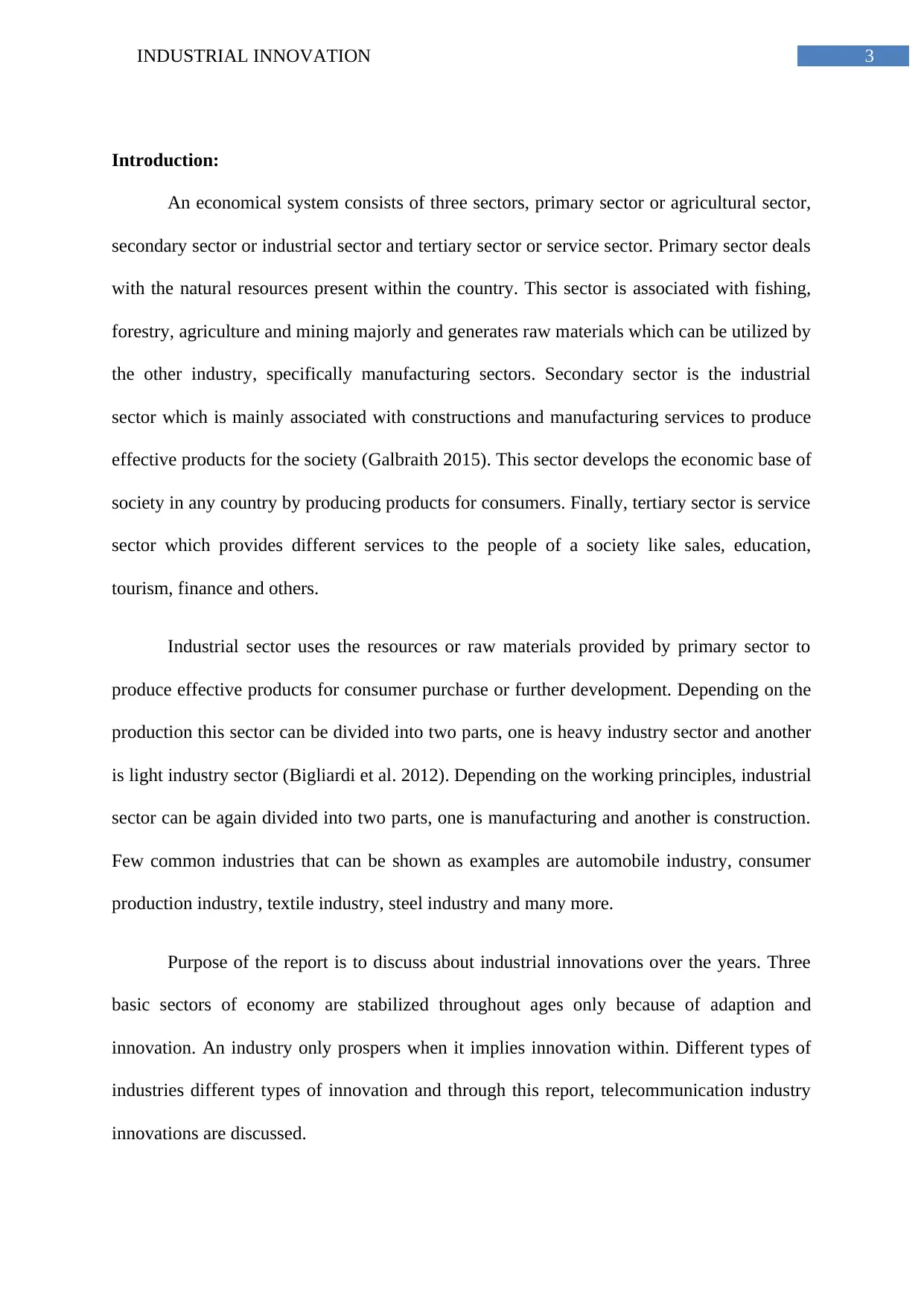
3INDUSTRIAL INNOVATION
Introduction:
An economical system consists of three sectors, primary sector or agricultural sector,
secondary sector or industrial sector and tertiary sector or service sector. Primary sector deals
with the natural resources present within the country. This sector is associated with fishing,
forestry, agriculture and mining majorly and generates raw materials which can be utilized by
the other industry, specifically manufacturing sectors. Secondary sector is the industrial
sector which is mainly associated with constructions and manufacturing services to produce
effective products for the society (Galbraith 2015). This sector develops the economic base of
society in any country by producing products for consumers. Finally, tertiary sector is service
sector which provides different services to the people of a society like sales, education,
tourism, finance and others.
Industrial sector uses the resources or raw materials provided by primary sector to
produce effective products for consumer purchase or further development. Depending on the
production this sector can be divided into two parts, one is heavy industry sector and another
is light industry sector (Bigliardi et al. 2012). Depending on the working principles, industrial
sector can be again divided into two parts, one is manufacturing and another is construction.
Few common industries that can be shown as examples are automobile industry, consumer
production industry, textile industry, steel industry and many more.
Purpose of the report is to discuss about industrial innovations over the years. Three
basic sectors of economy are stabilized throughout ages only because of adaption and
innovation. An industry only prospers when it implies innovation within. Different types of
industries different types of innovation and through this report, telecommunication industry
innovations are discussed.
Introduction:
An economical system consists of three sectors, primary sector or agricultural sector,
secondary sector or industrial sector and tertiary sector or service sector. Primary sector deals
with the natural resources present within the country. This sector is associated with fishing,
forestry, agriculture and mining majorly and generates raw materials which can be utilized by
the other industry, specifically manufacturing sectors. Secondary sector is the industrial
sector which is mainly associated with constructions and manufacturing services to produce
effective products for the society (Galbraith 2015). This sector develops the economic base of
society in any country by producing products for consumers. Finally, tertiary sector is service
sector which provides different services to the people of a society like sales, education,
tourism, finance and others.
Industrial sector uses the resources or raw materials provided by primary sector to
produce effective products for consumer purchase or further development. Depending on the
production this sector can be divided into two parts, one is heavy industry sector and another
is light industry sector (Bigliardi et al. 2012). Depending on the working principles, industrial
sector can be again divided into two parts, one is manufacturing and another is construction.
Few common industries that can be shown as examples are automobile industry, consumer
production industry, textile industry, steel industry and many more.
Purpose of the report is to discuss about industrial innovations over the years. Three
basic sectors of economy are stabilized throughout ages only because of adaption and
innovation. An industry only prospers when it implies innovation within. Different types of
industries different types of innovation and through this report, telecommunication industry
innovations are discussed.
Paraphrase This Document
Need a fresh take? Get an instant paraphrase of this document with our AI Paraphraser
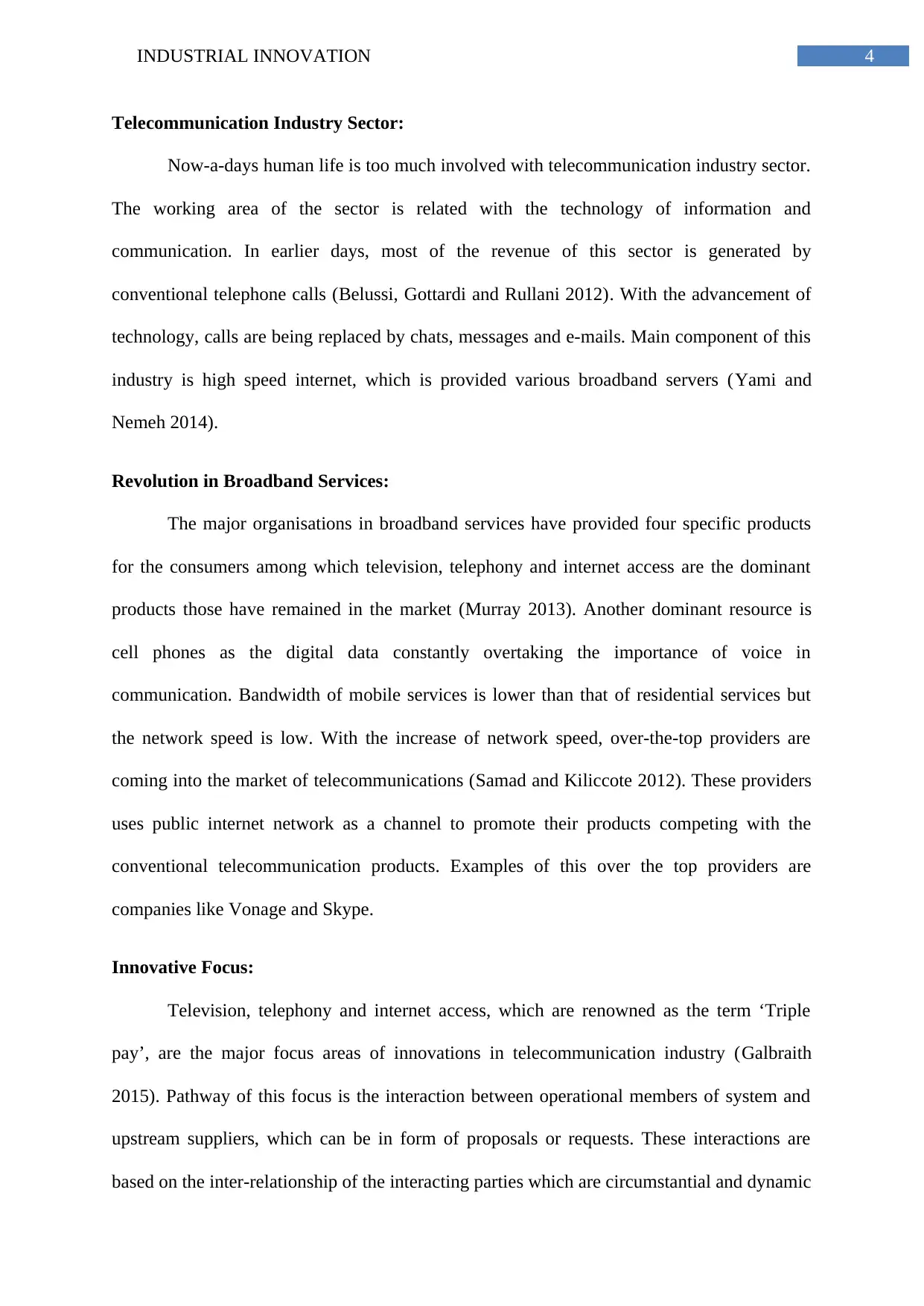
4INDUSTRIAL INNOVATION
Telecommunication Industry Sector:
Now-a-days human life is too much involved with telecommunication industry sector.
The working area of the sector is related with the technology of information and
communication. In earlier days, most of the revenue of this sector is generated by
conventional telephone calls (Belussi, Gottardi and Rullani 2012). With the advancement of
technology, calls are being replaced by chats, messages and e-mails. Main component of this
industry is high speed internet, which is provided various broadband servers (Yami and
Nemeh 2014).
Revolution in Broadband Services:
The major organisations in broadband services have provided four specific products
for the consumers among which television, telephony and internet access are the dominant
products those have remained in the market (Murray 2013). Another dominant resource is
cell phones as the digital data constantly overtaking the importance of voice in
communication. Bandwidth of mobile services is lower than that of residential services but
the network speed is low. With the increase of network speed, over-the-top providers are
coming into the market of telecommunications (Samad and Kiliccote 2012). These providers
uses public internet network as a channel to promote their products competing with the
conventional telecommunication products. Examples of this over the top providers are
companies like Vonage and Skype.
Innovative Focus:
Television, telephony and internet access, which are renowned as the term ‘Triple
pay’, are the major focus areas of innovations in telecommunication industry (Galbraith
2015). Pathway of this focus is the interaction between operational members of system and
upstream suppliers, which can be in form of proposals or requests. These interactions are
based on the inter-relationship of the interacting parties which are circumstantial and dynamic
Telecommunication Industry Sector:
Now-a-days human life is too much involved with telecommunication industry sector.
The working area of the sector is related with the technology of information and
communication. In earlier days, most of the revenue of this sector is generated by
conventional telephone calls (Belussi, Gottardi and Rullani 2012). With the advancement of
technology, calls are being replaced by chats, messages and e-mails. Main component of this
industry is high speed internet, which is provided various broadband servers (Yami and
Nemeh 2014).
Revolution in Broadband Services:
The major organisations in broadband services have provided four specific products
for the consumers among which television, telephony and internet access are the dominant
products those have remained in the market (Murray 2013). Another dominant resource is
cell phones as the digital data constantly overtaking the importance of voice in
communication. Bandwidth of mobile services is lower than that of residential services but
the network speed is low. With the increase of network speed, over-the-top providers are
coming into the market of telecommunications (Samad and Kiliccote 2012). These providers
uses public internet network as a channel to promote their products competing with the
conventional telecommunication products. Examples of this over the top providers are
companies like Vonage and Skype.
Innovative Focus:
Television, telephony and internet access, which are renowned as the term ‘Triple
pay’, are the major focus areas of innovations in telecommunication industry (Galbraith
2015). Pathway of this focus is the interaction between operational members of system and
upstream suppliers, which can be in form of proposals or requests. These interactions are
based on the inter-relationship of the interacting parties which are circumstantial and dynamic
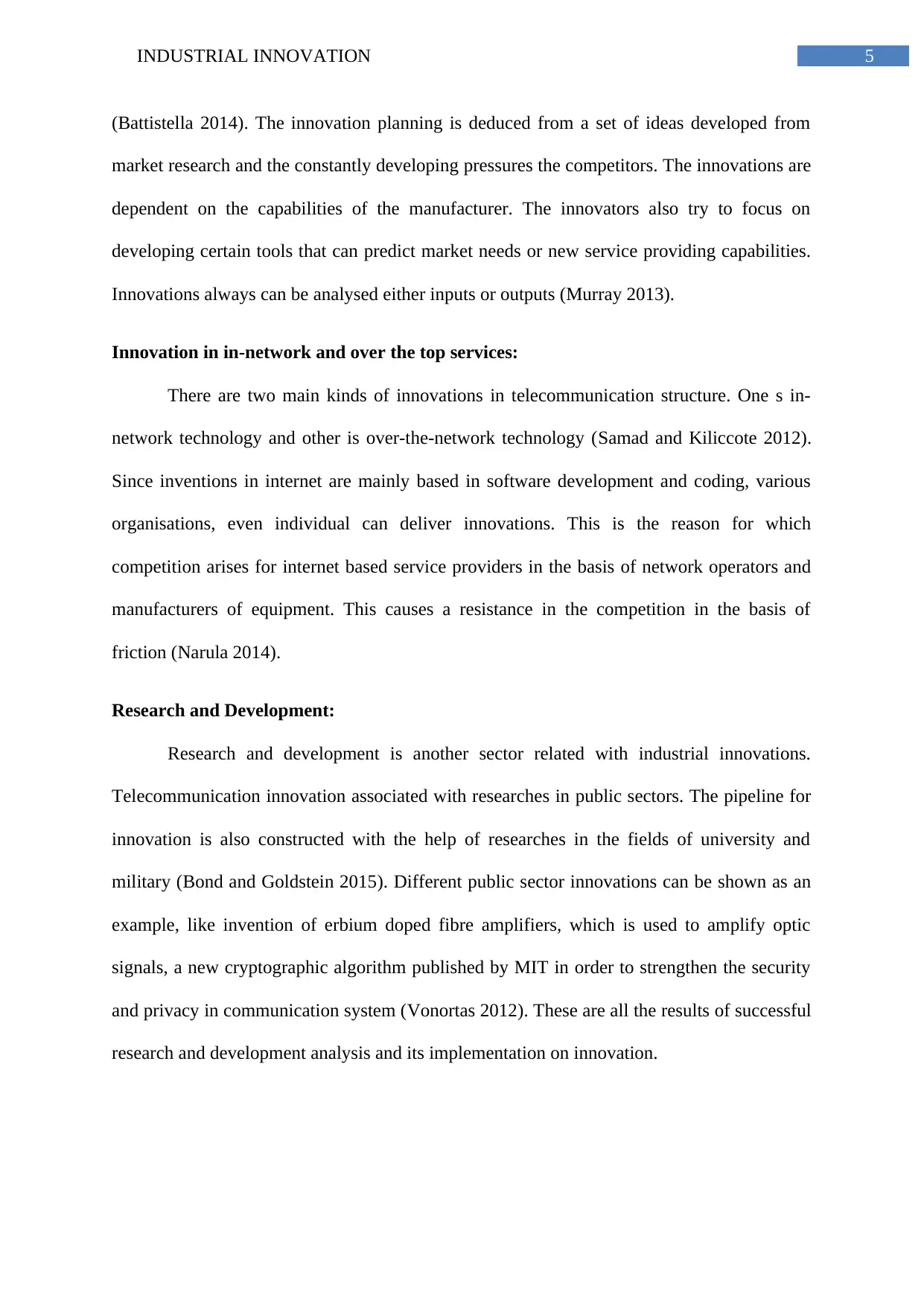
5INDUSTRIAL INNOVATION
(Battistella 2014). The innovation planning is deduced from a set of ideas developed from
market research and the constantly developing pressures the competitors. The innovations are
dependent on the capabilities of the manufacturer. The innovators also try to focus on
developing certain tools that can predict market needs or new service providing capabilities.
Innovations always can be analysed either inputs or outputs (Murray 2013).
Innovation in in-network and over the top services:
There are two main kinds of innovations in telecommunication structure. One s in-
network technology and other is over-the-network technology (Samad and Kiliccote 2012).
Since inventions in internet are mainly based in software development and coding, various
organisations, even individual can deliver innovations. This is the reason for which
competition arises for internet based service providers in the basis of network operators and
manufacturers of equipment. This causes a resistance in the competition in the basis of
friction (Narula 2014).
Research and Development:
Research and development is another sector related with industrial innovations.
Telecommunication innovation associated with researches in public sectors. The pipeline for
innovation is also constructed with the help of researches in the fields of university and
military (Bond and Goldstein 2015). Different public sector innovations can be shown as an
example, like invention of erbium doped fibre amplifiers, which is used to amplify optic
signals, a new cryptographic algorithm published by MIT in order to strengthen the security
and privacy in communication system (Vonortas 2012). These are all the results of successful
research and development analysis and its implementation on innovation.
(Battistella 2014). The innovation planning is deduced from a set of ideas developed from
market research and the constantly developing pressures the competitors. The innovations are
dependent on the capabilities of the manufacturer. The innovators also try to focus on
developing certain tools that can predict market needs or new service providing capabilities.
Innovations always can be analysed either inputs or outputs (Murray 2013).
Innovation in in-network and over the top services:
There are two main kinds of innovations in telecommunication structure. One s in-
network technology and other is over-the-network technology (Samad and Kiliccote 2012).
Since inventions in internet are mainly based in software development and coding, various
organisations, even individual can deliver innovations. This is the reason for which
competition arises for internet based service providers in the basis of network operators and
manufacturers of equipment. This causes a resistance in the competition in the basis of
friction (Narula 2014).
Research and Development:
Research and development is another sector related with industrial innovations.
Telecommunication innovation associated with researches in public sectors. The pipeline for
innovation is also constructed with the help of researches in the fields of university and
military (Bond and Goldstein 2015). Different public sector innovations can be shown as an
example, like invention of erbium doped fibre amplifiers, which is used to amplify optic
signals, a new cryptographic algorithm published by MIT in order to strengthen the security
and privacy in communication system (Vonortas 2012). These are all the results of successful
research and development analysis and its implementation on innovation.
⊘ This is a preview!⊘
Do you want full access?
Subscribe today to unlock all pages.

Trusted by 1+ million students worldwide
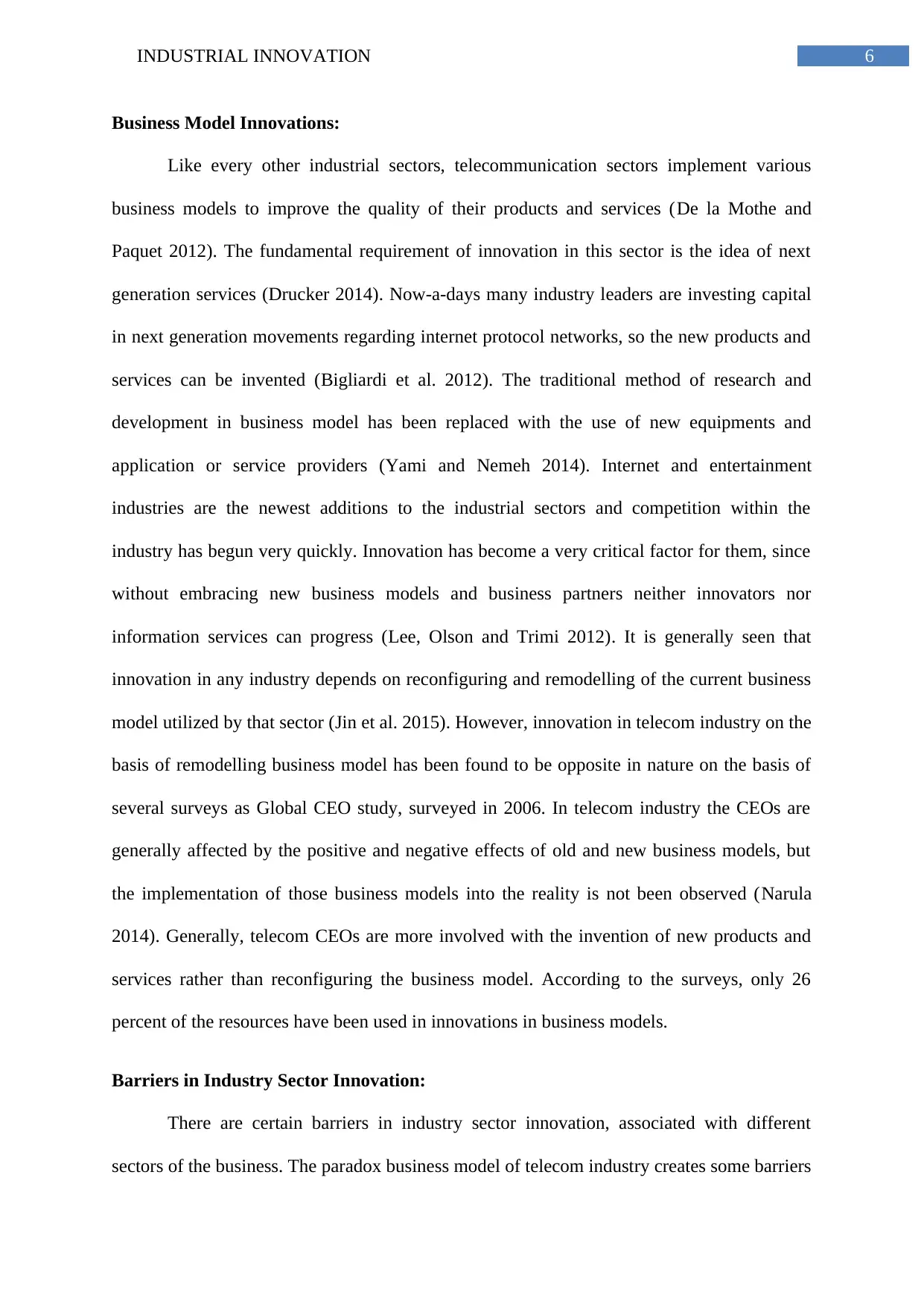
6INDUSTRIAL INNOVATION
Business Model Innovations:
Like every other industrial sectors, telecommunication sectors implement various
business models to improve the quality of their products and services (De la Mothe and
Paquet 2012). The fundamental requirement of innovation in this sector is the idea of next
generation services (Drucker 2014). Now-a-days many industry leaders are investing capital
in next generation movements regarding internet protocol networks, so the new products and
services can be invented (Bigliardi et al. 2012). The traditional method of research and
development in business model has been replaced with the use of new equipments and
application or service providers (Yami and Nemeh 2014). Internet and entertainment
industries are the newest additions to the industrial sectors and competition within the
industry has begun very quickly. Innovation has become a very critical factor for them, since
without embracing new business models and business partners neither innovators nor
information services can progress (Lee, Olson and Trimi 2012). It is generally seen that
innovation in any industry depends on reconfiguring and remodelling of the current business
model utilized by that sector (Jin et al. 2015). However, innovation in telecom industry on the
basis of remodelling business model has been found to be opposite in nature on the basis of
several surveys as Global CEO study, surveyed in 2006. In telecom industry the CEOs are
generally affected by the positive and negative effects of old and new business models, but
the implementation of those business models into the reality is not been observed (Narula
2014). Generally, telecom CEOs are more involved with the invention of new products and
services rather than reconfiguring the business model. According to the surveys, only 26
percent of the resources have been used in innovations in business models.
Barriers in Industry Sector Innovation:
There are certain barriers in industry sector innovation, associated with different
sectors of the business. The paradox business model of telecom industry creates some barriers
Business Model Innovations:
Like every other industrial sectors, telecommunication sectors implement various
business models to improve the quality of their products and services (De la Mothe and
Paquet 2012). The fundamental requirement of innovation in this sector is the idea of next
generation services (Drucker 2014). Now-a-days many industry leaders are investing capital
in next generation movements regarding internet protocol networks, so the new products and
services can be invented (Bigliardi et al. 2012). The traditional method of research and
development in business model has been replaced with the use of new equipments and
application or service providers (Yami and Nemeh 2014). Internet and entertainment
industries are the newest additions to the industrial sectors and competition within the
industry has begun very quickly. Innovation has become a very critical factor for them, since
without embracing new business models and business partners neither innovators nor
information services can progress (Lee, Olson and Trimi 2012). It is generally seen that
innovation in any industry depends on reconfiguring and remodelling of the current business
model utilized by that sector (Jin et al. 2015). However, innovation in telecom industry on the
basis of remodelling business model has been found to be opposite in nature on the basis of
several surveys as Global CEO study, surveyed in 2006. In telecom industry the CEOs are
generally affected by the positive and negative effects of old and new business models, but
the implementation of those business models into the reality is not been observed (Narula
2014). Generally, telecom CEOs are more involved with the invention of new products and
services rather than reconfiguring the business model. According to the surveys, only 26
percent of the resources have been used in innovations in business models.
Barriers in Industry Sector Innovation:
There are certain barriers in industry sector innovation, associated with different
sectors of the business. The paradox business model of telecom industry creates some barriers
Paraphrase This Document
Need a fresh take? Get an instant paraphrase of this document with our AI Paraphraser
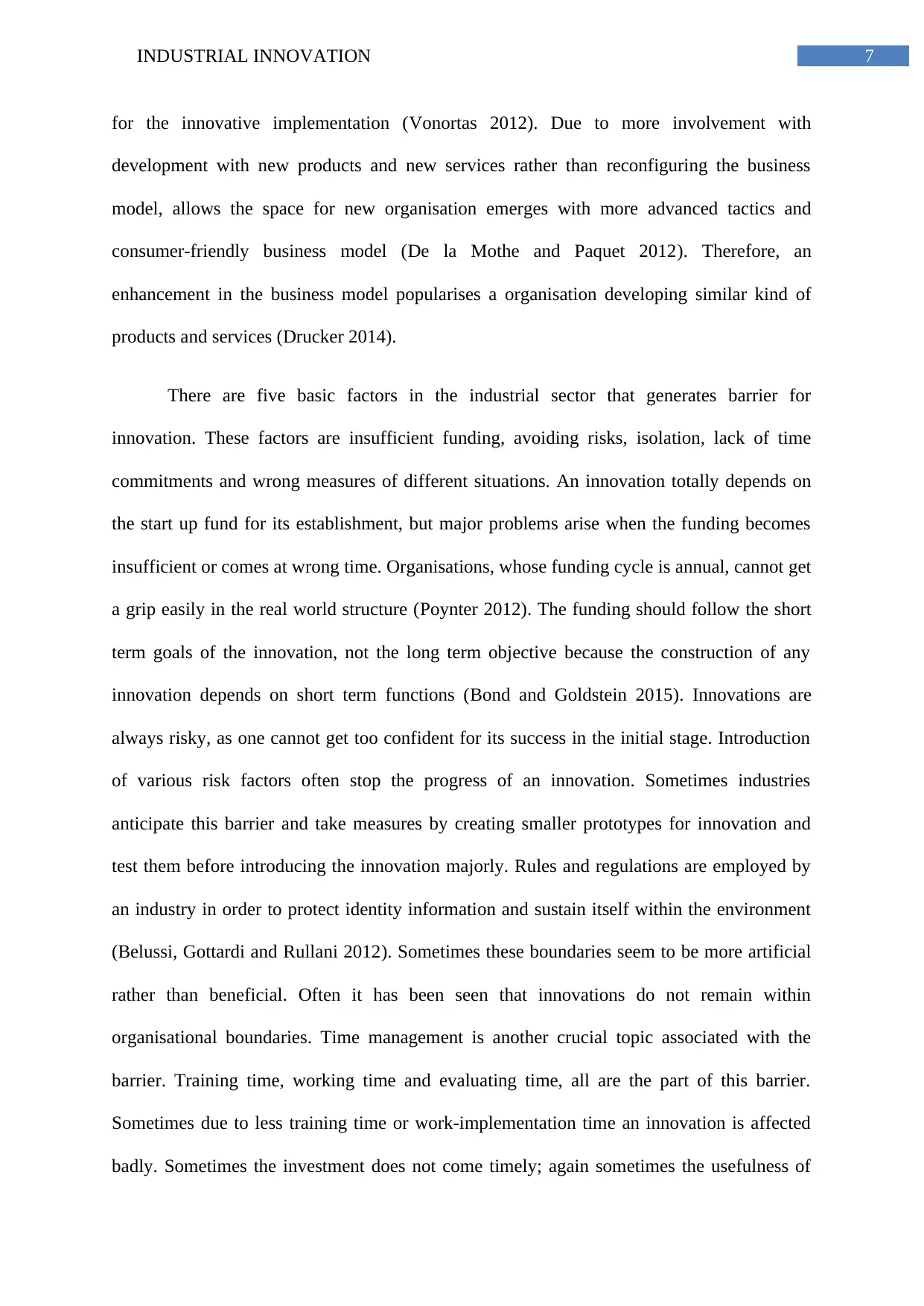
7INDUSTRIAL INNOVATION
for the innovative implementation (Vonortas 2012). Due to more involvement with
development with new products and new services rather than reconfiguring the business
model, allows the space for new organisation emerges with more advanced tactics and
consumer-friendly business model (De la Mothe and Paquet 2012). Therefore, an
enhancement in the business model popularises a organisation developing similar kind of
products and services (Drucker 2014).
There are five basic factors in the industrial sector that generates barrier for
innovation. These factors are insufficient funding, avoiding risks, isolation, lack of time
commitments and wrong measures of different situations. An innovation totally depends on
the start up fund for its establishment, but major problems arise when the funding becomes
insufficient or comes at wrong time. Organisations, whose funding cycle is annual, cannot get
a grip easily in the real world structure (Poynter 2012). The funding should follow the short
term goals of the innovation, not the long term objective because the construction of any
innovation depends on short term functions (Bond and Goldstein 2015). Innovations are
always risky, as one cannot get too confident for its success in the initial stage. Introduction
of various risk factors often stop the progress of an innovation. Sometimes industries
anticipate this barrier and take measures by creating smaller prototypes for innovation and
test them before introducing the innovation majorly. Rules and regulations are employed by
an industry in order to protect identity information and sustain itself within the environment
(Belussi, Gottardi and Rullani 2012). Sometimes these boundaries seem to be more artificial
rather than beneficial. Often it has been seen that innovations do not remain within
organisational boundaries. Time management is another crucial topic associated with the
barrier. Training time, working time and evaluating time, all are the part of this barrier.
Sometimes due to less training time or work-implementation time an innovation is affected
badly. Sometimes the investment does not come timely; again sometimes the usefulness of
for the innovative implementation (Vonortas 2012). Due to more involvement with
development with new products and new services rather than reconfiguring the business
model, allows the space for new organisation emerges with more advanced tactics and
consumer-friendly business model (De la Mothe and Paquet 2012). Therefore, an
enhancement in the business model popularises a organisation developing similar kind of
products and services (Drucker 2014).
There are five basic factors in the industrial sector that generates barrier for
innovation. These factors are insufficient funding, avoiding risks, isolation, lack of time
commitments and wrong measures of different situations. An innovation totally depends on
the start up fund for its establishment, but major problems arise when the funding becomes
insufficient or comes at wrong time. Organisations, whose funding cycle is annual, cannot get
a grip easily in the real world structure (Poynter 2012). The funding should follow the short
term goals of the innovation, not the long term objective because the construction of any
innovation depends on short term functions (Bond and Goldstein 2015). Innovations are
always risky, as one cannot get too confident for its success in the initial stage. Introduction
of various risk factors often stop the progress of an innovation. Sometimes industries
anticipate this barrier and take measures by creating smaller prototypes for innovation and
test them before introducing the innovation majorly. Rules and regulations are employed by
an industry in order to protect identity information and sustain itself within the environment
(Belussi, Gottardi and Rullani 2012). Sometimes these boundaries seem to be more artificial
rather than beneficial. Often it has been seen that innovations do not remain within
organisational boundaries. Time management is another crucial topic associated with the
barrier. Training time, working time and evaluating time, all are the part of this barrier.
Sometimes due to less training time or work-implementation time an innovation is affected
badly. Sometimes the investment does not come timely; again sometimes the usefulness of
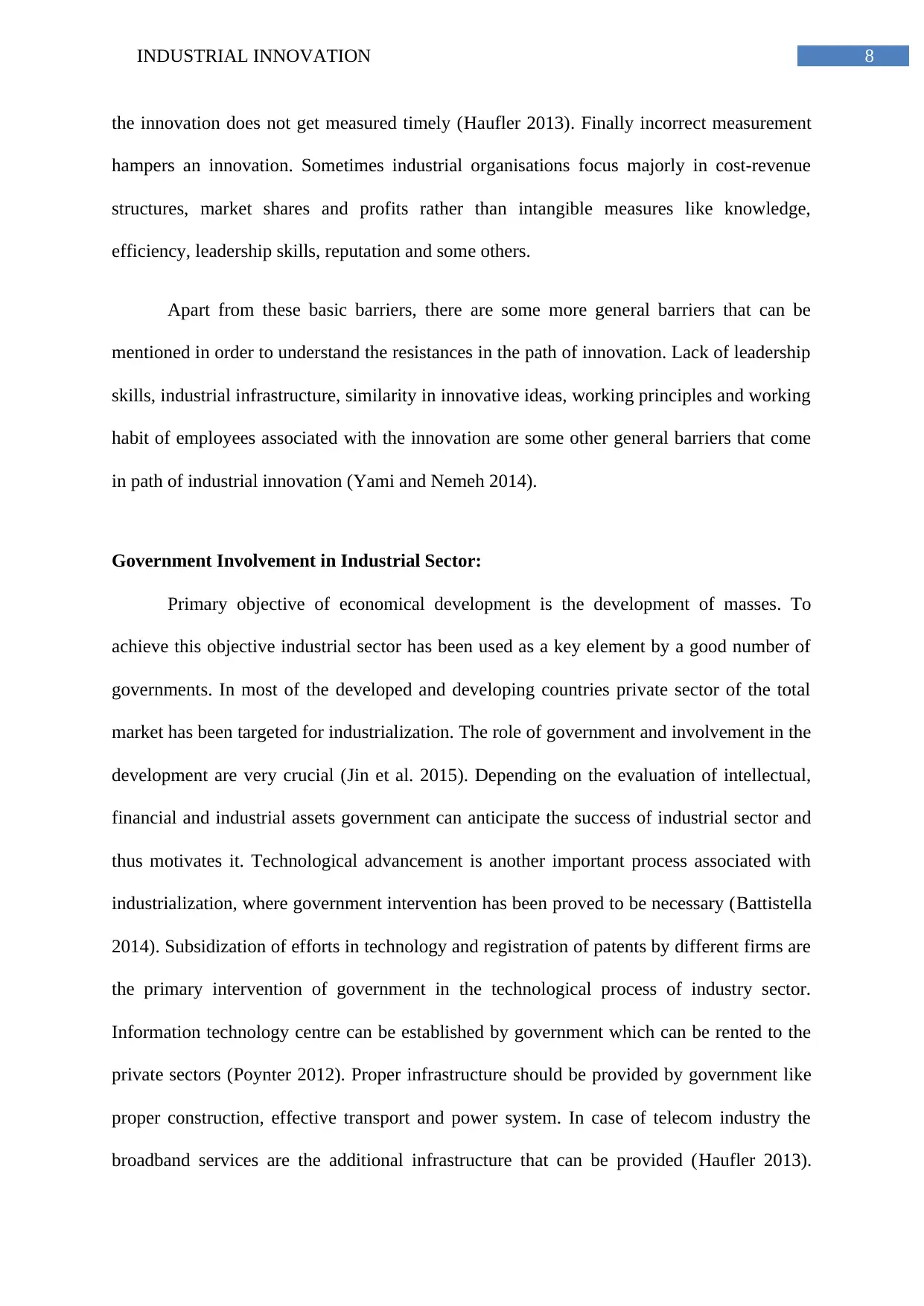
8INDUSTRIAL INNOVATION
the innovation does not get measured timely (Haufler 2013). Finally incorrect measurement
hampers an innovation. Sometimes industrial organisations focus majorly in cost-revenue
structures, market shares and profits rather than intangible measures like knowledge,
efficiency, leadership skills, reputation and some others.
Apart from these basic barriers, there are some more general barriers that can be
mentioned in order to understand the resistances in the path of innovation. Lack of leadership
skills, industrial infrastructure, similarity in innovative ideas, working principles and working
habit of employees associated with the innovation are some other general barriers that come
in path of industrial innovation (Yami and Nemeh 2014).
Government Involvement in Industrial Sector:
Primary objective of economical development is the development of masses. To
achieve this objective industrial sector has been used as a key element by a good number of
governments. In most of the developed and developing countries private sector of the total
market has been targeted for industrialization. The role of government and involvement in the
development are very crucial (Jin et al. 2015). Depending on the evaluation of intellectual,
financial and industrial assets government can anticipate the success of industrial sector and
thus motivates it. Technological advancement is another important process associated with
industrialization, where government intervention has been proved to be necessary (Battistella
2014). Subsidization of efforts in technology and registration of patents by different firms are
the primary intervention of government in the technological process of industry sector.
Information technology centre can be established by government which can be rented to the
private sectors (Poynter 2012). Proper infrastructure should be provided by government like
proper construction, effective transport and power system. In case of telecom industry the
broadband services are the additional infrastructure that can be provided (Haufler 2013).
the innovation does not get measured timely (Haufler 2013). Finally incorrect measurement
hampers an innovation. Sometimes industrial organisations focus majorly in cost-revenue
structures, market shares and profits rather than intangible measures like knowledge,
efficiency, leadership skills, reputation and some others.
Apart from these basic barriers, there are some more general barriers that can be
mentioned in order to understand the resistances in the path of innovation. Lack of leadership
skills, industrial infrastructure, similarity in innovative ideas, working principles and working
habit of employees associated with the innovation are some other general barriers that come
in path of industrial innovation (Yami and Nemeh 2014).
Government Involvement in Industrial Sector:
Primary objective of economical development is the development of masses. To
achieve this objective industrial sector has been used as a key element by a good number of
governments. In most of the developed and developing countries private sector of the total
market has been targeted for industrialization. The role of government and involvement in the
development are very crucial (Jin et al. 2015). Depending on the evaluation of intellectual,
financial and industrial assets government can anticipate the success of industrial sector and
thus motivates it. Technological advancement is another important process associated with
industrialization, where government intervention has been proved to be necessary (Battistella
2014). Subsidization of efforts in technology and registration of patents by different firms are
the primary intervention of government in the technological process of industry sector.
Information technology centre can be established by government which can be rented to the
private sectors (Poynter 2012). Proper infrastructure should be provided by government like
proper construction, effective transport and power system. In case of telecom industry the
broadband services are the additional infrastructure that can be provided (Haufler 2013).
⊘ This is a preview!⊘
Do you want full access?
Subscribe today to unlock all pages.

Trusted by 1+ million students worldwide
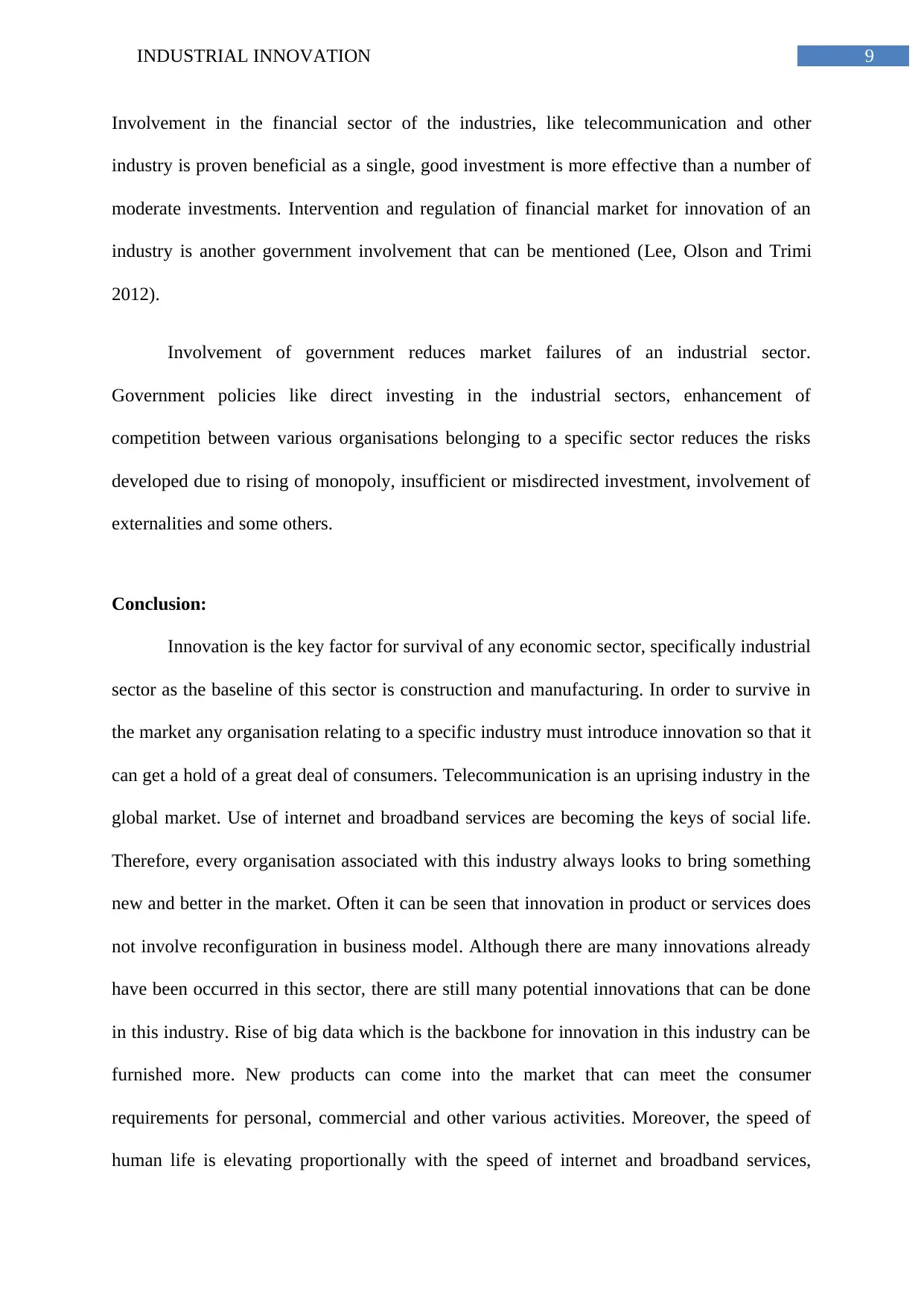
9INDUSTRIAL INNOVATION
Involvement in the financial sector of the industries, like telecommunication and other
industry is proven beneficial as a single, good investment is more effective than a number of
moderate investments. Intervention and regulation of financial market for innovation of an
industry is another government involvement that can be mentioned (Lee, Olson and Trimi
2012).
Involvement of government reduces market failures of an industrial sector.
Government policies like direct investing in the industrial sectors, enhancement of
competition between various organisations belonging to a specific sector reduces the risks
developed due to rising of monopoly, insufficient or misdirected investment, involvement of
externalities and some others.
Conclusion:
Innovation is the key factor for survival of any economic sector, specifically industrial
sector as the baseline of this sector is construction and manufacturing. In order to survive in
the market any organisation relating to a specific industry must introduce innovation so that it
can get a hold of a great deal of consumers. Telecommunication is an uprising industry in the
global market. Use of internet and broadband services are becoming the keys of social life.
Therefore, every organisation associated with this industry always looks to bring something
new and better in the market. Often it can be seen that innovation in product or services does
not involve reconfiguration in business model. Although there are many innovations already
have been occurred in this sector, there are still many potential innovations that can be done
in this industry. Rise of big data which is the backbone for innovation in this industry can be
furnished more. New products can come into the market that can meet the consumer
requirements for personal, commercial and other various activities. Moreover, the speed of
human life is elevating proportionally with the speed of internet and broadband services,
Involvement in the financial sector of the industries, like telecommunication and other
industry is proven beneficial as a single, good investment is more effective than a number of
moderate investments. Intervention and regulation of financial market for innovation of an
industry is another government involvement that can be mentioned (Lee, Olson and Trimi
2012).
Involvement of government reduces market failures of an industrial sector.
Government policies like direct investing in the industrial sectors, enhancement of
competition between various organisations belonging to a specific sector reduces the risks
developed due to rising of monopoly, insufficient or misdirected investment, involvement of
externalities and some others.
Conclusion:
Innovation is the key factor for survival of any economic sector, specifically industrial
sector as the baseline of this sector is construction and manufacturing. In order to survive in
the market any organisation relating to a specific industry must introduce innovation so that it
can get a hold of a great deal of consumers. Telecommunication is an uprising industry in the
global market. Use of internet and broadband services are becoming the keys of social life.
Therefore, every organisation associated with this industry always looks to bring something
new and better in the market. Often it can be seen that innovation in product or services does
not involve reconfiguration in business model. Although there are many innovations already
have been occurred in this sector, there are still many potential innovations that can be done
in this industry. Rise of big data which is the backbone for innovation in this industry can be
furnished more. New products can come into the market that can meet the consumer
requirements for personal, commercial and other various activities. Moreover, the speed of
human life is elevating proportionally with the speed of internet and broadband services,
Paraphrase This Document
Need a fresh take? Get an instant paraphrase of this document with our AI Paraphraser

10INDUSTRIAL INNOVATION
which develops the field for more innovation of products and services in the industrial
sectors.
which develops the field for more innovation of products and services in the industrial
sectors.
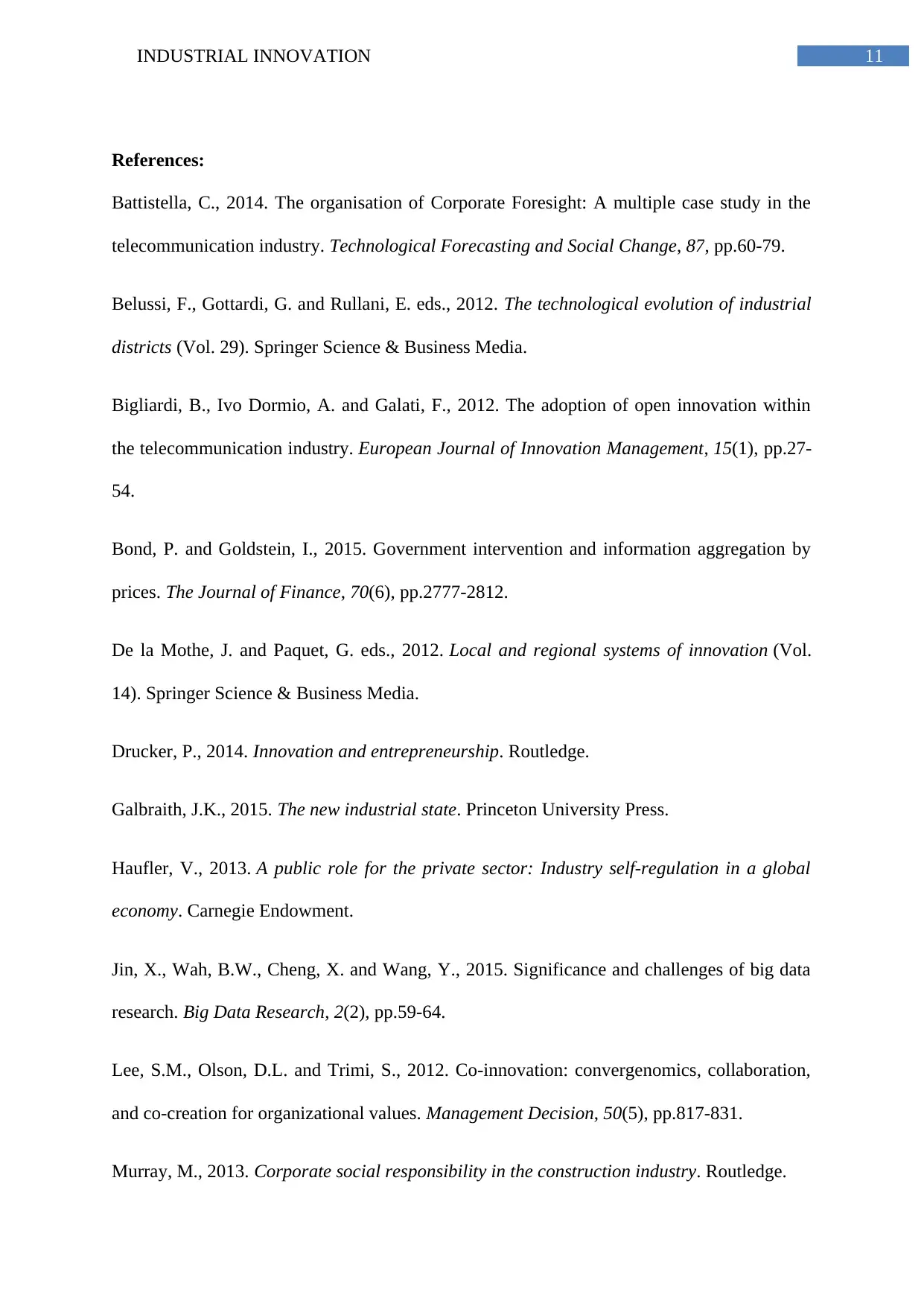
11INDUSTRIAL INNOVATION
References:
Battistella, C., 2014. The organisation of Corporate Foresight: A multiple case study in the
telecommunication industry. Technological Forecasting and Social Change, 87, pp.60-79.
Belussi, F., Gottardi, G. and Rullani, E. eds., 2012. The technological evolution of industrial
districts (Vol. 29). Springer Science & Business Media.
Bigliardi, B., Ivo Dormio, A. and Galati, F., 2012. The adoption of open innovation within
the telecommunication industry. European Journal of Innovation Management, 15(1), pp.27-
54.
Bond, P. and Goldstein, I., 2015. Government intervention and information aggregation by
prices. The Journal of Finance, 70(6), pp.2777-2812.
De la Mothe, J. and Paquet, G. eds., 2012. Local and regional systems of innovation (Vol.
14). Springer Science & Business Media.
Drucker, P., 2014. Innovation and entrepreneurship. Routledge.
Galbraith, J.K., 2015. The new industrial state. Princeton University Press.
Haufler, V., 2013. A public role for the private sector: Industry self-regulation in a global
economy. Carnegie Endowment.
Jin, X., Wah, B.W., Cheng, X. and Wang, Y., 2015. Significance and challenges of big data
research. Big Data Research, 2(2), pp.59-64.
Lee, S.M., Olson, D.L. and Trimi, S., 2012. Co-innovation: convergenomics, collaboration,
and co-creation for organizational values. Management Decision, 50(5), pp.817-831.
Murray, M., 2013. Corporate social responsibility in the construction industry. Routledge.
References:
Battistella, C., 2014. The organisation of Corporate Foresight: A multiple case study in the
telecommunication industry. Technological Forecasting and Social Change, 87, pp.60-79.
Belussi, F., Gottardi, G. and Rullani, E. eds., 2012. The technological evolution of industrial
districts (Vol. 29). Springer Science & Business Media.
Bigliardi, B., Ivo Dormio, A. and Galati, F., 2012. The adoption of open innovation within
the telecommunication industry. European Journal of Innovation Management, 15(1), pp.27-
54.
Bond, P. and Goldstein, I., 2015. Government intervention and information aggregation by
prices. The Journal of Finance, 70(6), pp.2777-2812.
De la Mothe, J. and Paquet, G. eds., 2012. Local and regional systems of innovation (Vol.
14). Springer Science & Business Media.
Drucker, P., 2014. Innovation and entrepreneurship. Routledge.
Galbraith, J.K., 2015. The new industrial state. Princeton University Press.
Haufler, V., 2013. A public role for the private sector: Industry self-regulation in a global
economy. Carnegie Endowment.
Jin, X., Wah, B.W., Cheng, X. and Wang, Y., 2015. Significance and challenges of big data
research. Big Data Research, 2(2), pp.59-64.
Lee, S.M., Olson, D.L. and Trimi, S., 2012. Co-innovation: convergenomics, collaboration,
and co-creation for organizational values. Management Decision, 50(5), pp.817-831.
Murray, M., 2013. Corporate social responsibility in the construction industry. Routledge.
⊘ This is a preview!⊘
Do you want full access?
Subscribe today to unlock all pages.

Trusted by 1+ million students worldwide
1 out of 13
Related Documents
Your All-in-One AI-Powered Toolkit for Academic Success.
+13062052269
info@desklib.com
Available 24*7 on WhatsApp / Email
![[object Object]](/_next/static/media/star-bottom.7253800d.svg)
Unlock your academic potential
Copyright © 2020–2025 A2Z Services. All Rights Reserved. Developed and managed by ZUCOL.





